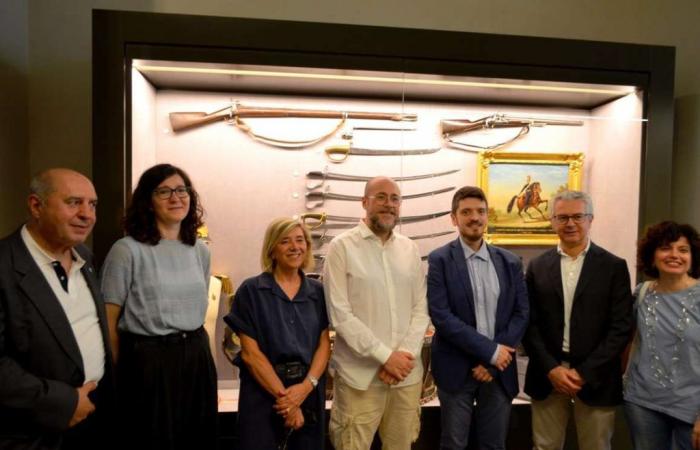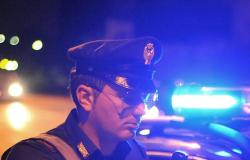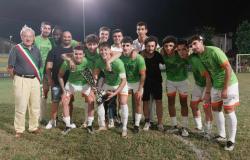PRATO – The Museum of Palazzo Pretorio brings to the city’s attention another nucleus of deposits and presents a new display case dedicated to some relics belonging to the former Museum of the Risorgimento, set up in the Palace in the early twentieth century.
Thus comes to an end the expansion project which recently saw the inauguration of the Dai Depositi al Museo room, of the Prato before Prato section and of a part of the sensorial tactile itinerary for a Museum that also wishes to share and be an ambassador of the history of territory.
«With this new section our Civic Museum is further strengthened and gives us a complete picture of the history of the city», states the mayor Ilaria Bugetti. «Prato had a leading role in the Risorgimento, well illustrated by the objects exhibited in Palazzo Pretorio. Objects donated to the Municipality over the years by the same people from Prato who actively took part in this fundamental passage in the history of our country. A new exhibition area which also well represents the high scientific value of the work carried out by director Rita Iacopino and all the staff to enhance the great heritage of our Museum. A strong point and a source of pride for us municipal administrators.”
In the new section you can admire rifles, sabers, helmets and uniform accessories, coming mainly from citizens of Prato who, starting from the end of the nineteenth century, wanted to donate to the Municipality rare testimonies of their participation in the Risorgimento epic.
«The complete survey of the material belonging to the ancient Museum, which required careful inventory, dating and documentation, led to the final decision to create a section dedicated to this period, completing the layout of the ground floor of the museum, which tells, through particular objects and significant works, the history of the city», explains Rita Iacopino, director of the Palazzo Pretorio Museum.
The inventory verification work for the reconnaissance of weapons and war materials was carried out in agreement with the Tuscan Coordination for the Promotion of Risorgimento Values and with the help of the ARMORUM Ars Association of Dovadola. The restoration of some of the objects on display was carried out by the Restoration Laboratory of the Textile Museum and by Jennifer Di Fina.
In the new display case, a small but significant exhibition is reserved for Adriano Zarini, soldier and patriot, which contains a painting by Tommaso Palloni, which portrays him on horseback wearing the Tuscan Dragoon uniform, and the precious chenille helmet, the traveling pistols, and the dragoon boots with the initials A and Z on the sole which, made of shoemaker’s nails, left footprints in the mud or dust.
A focus on the period 1848-49, when the people of Prato participated in large numbers in the heated democratic season that culminated with the Tuscan Provisional Government of Guerrazzi, Mazzoni and Montanelli.
On display are chiseled helmets that belonged to the civic guard, epaulettes, uniform accessories and sabres of rare beauty that with their decorations represent the artistic skills of the Tuscan gunsmiths of the 19th century. Alongside this, weapons such as those with which the Tuscans fought at Curtatone and Montanara as well as the famous medal that decorated the chest of the veterans of that battle.
«This exhibition space is one of the few in the region dedicated to the Risorgimento: in Palazzo Vecchio there is a room with busts and paintings dedicated to Florence as the capital; in Lucca in the Palazzo Ducale, a museum of the Risorgimento; in Modigliana one dedicated to Don Giovanni Verità and Garibaldi’s legacy in Tuscany. The reopening to the public of a space like this, even if small, therefore represents a fundamental tool for preserving the memory of the events and characters that led to the unification of Italy”, as recalled by Alessandro Minardi, historian and vice-president of the Romagna Tuscany Committee for the promotion of Risorgimento values.
For further information on the Museum of the Risorgimento and the historical period it represents, the Museum of Palazzo Pretorio, in collaboration with the Biblioteca Roncioniana and the State Archives of Prato, organizes in autumn the series of meetings The Risorgimento in Prato. History, memory, documents, the museum, open to the public.
September 20, 2024 at 5:00 pm – Palazzo Pretorio Museum (Piazza del Comune, Prato)
Speakers: Rita Iacopino, director of the Palazzo Pretorio Museum in Prato; Christian Satto, researcher of contemporary history at the University for Foreigners of Siena and president of the Coordination of Committees for the Promotion of Risorgimento values.
October 9, 2024 at 5:00 p.m. – State Archives (Via Ser Lapo Mazzei 41, Prato)
Speakers: Niccolò Lucarelli, military historian; Adele Manzoni, archivist.
23 October 2024 at 5.00 pm – Roncioniana Library (Piazza San Francesco 27, Prato)
Speakers: Andrea Giaconi, research fellow at the University of Calabria and secretary of the Prato Committee for the Promotion of Risorgimento values; Alessandro Minardi, historian and vice-president of the Romagna Tuscany Committee for the promotion of Risorgimento values; Giovanni Pestelli, Roncioniana Library.
Located at least since 1912 in a small room on the first floor of the Palazzo Pretorio, the Museum of the Risorgimento was formed with the first donations, in particular that of Adriano Zarini, in the early twentieth century.
Part of this first exhibition were National Guard mounts, medals, rifles with bayonet, four National Guard drums, two saddles (dragon style and English style), harnesses, two small paintings by Palloni, one of which is now exhibited in the Town Hall, swords, sabers, revolvers and other relics and objects, including the nineteenth-century lucchi and the Gonfalonier’s Mace displayed on this floor.
Like other Risorgimento museums that arose between the end of the 19th century and the beginning of the 20th century, the Prato museum aimed to educate the people in patriotic ideals, thanks also to the contribution of the many donations that reached the Municipality and then the Museum in that period Civic, which became the natural container of the city’s memories, promoting historical knowledge of the more recent past.
In 1919 Angiolo Badiani was responsible for the reorganization of the Risorgimento museum, which collected the memories of the war that had just ended with the collaboration of the Committee for the erection of a monument to the fallen and of General Nannicini, who contributed to significantly increasing the collection of memorabilia. Following the restoration work on the first floor of the building, completed in 1926, the Risorgimento museum was moved to the first mezzanine where the most recent acquisitions relating to the Great War and the increasingly numerous donations from private individuals were placed: bombs were added, bomb launchers, rifles, letters, portraits with dedication “of all the leaders of the Great War” and printed proclamations.
During Fascism, which was intended as the ideal continuation of the Risorgimento, other materials were collected, so much so that in 1934 the Museum of the Risorgimento needed more space and was moved to the largest room on the same mezzanine. In the following years, new donations increased its collection, which was enriched with numerous engravings, letters and objects, including the helmet and sabre of the architect Fortunato Rocchi, donated by his son Raffaello in 1936. In the same year, the Cironi Fund arrived at the museum, consisting of manuscripts, mementos and miscellanies of the patriot from Prato, Piero Cironi, now kept at the State Archives of Prato. Much of the collection of the Museum of the Risorgimento was incorporated into the large exhibition dedicated to the Risorgimento that took place on the first floor of the Palazzo Pretorio in September-October 1937 and in which the Biblioteca Roncioniana, the Convitto Cicognini, the Arciconfraternita della Misericordia, the Ospedale della Misericordia and private citizens participated, making relics, weapons, documents, prints and postcards available to the community for what was the last major event around the Museum of the Risorgimento, which was increasingly involved in fascist-style propaganda.
After the Second World War and the new layout of the Civic Museum by Giuseppe Marchini in 1953, the relics and materials of the Risorgimento Museum remained kept in storage, surrounded by a sort of damnatio memoriae for what they represented during the fascist period. The new cataloging of these objects and the setting up of this showcase have the aim of renewing interest in the Risorgimento epic, bearer of values of independence and freedom, with a privileged vision aimed at local events and protagonists.






